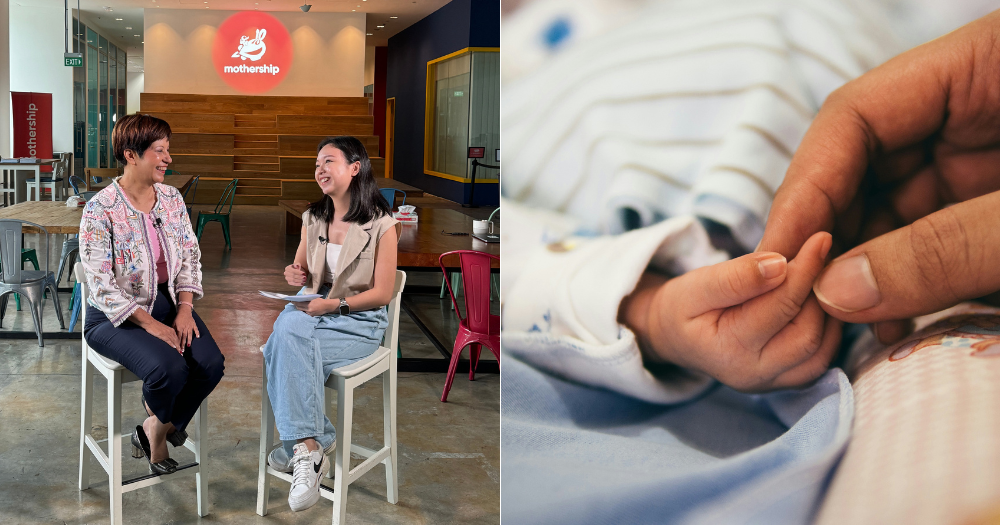In case you missed it, Prime Minister Lawrence Wong announced in his maiden National Day Rally speech that parents will receive an additional 10 weeks of new shared parental leave and more paternity leave.
Once implemented, the changes would bring the total amount of parental leave between parents to 30 weeks or 7.5 months, PM Wong said.
Speaking to Mothership about these new policies, Minister in Prime Minister's Office (PMO) Indranee Rajah shared that the government is trying to create a new norm and balance between work and family commitments.
Why now?
Upon entering the PMO, Rajah was tasked with researching marriage and parenthood, so one of the first things she did was have conversations with young parents.
What stood out from all those conversations was the need for parents to spend more time with their children.
With the additional 10 weeks and other forms of leave, like maternity leave, the total of 30 weeks given to parents would be "a good period for parents of newborns to bond with and care for their children".
In addition, Rajah shared that while some mothers want to spend more time with their children, especially in the first 18 months, many other mothers expressed their wish to return to work.
The younger generation of fathers has also expressed their desire to spend more time with their newborns, but their employers still have not "taken on board this idea of parenting on the part of fathers."
"So we did realise that we would have to make it mandatory. We want to make it work," Rajah explained as she pointed out that voluntary paternity leave led some employers not to feel the need to give fathers the leave.
"So we felt that we should make this mandatory to send a very clear signal that dads have an important role to play in parenting as well."
One branch of many
In February 2024, Rajah shared in parliament that Singapore's TRF dropped below 1.0, with preliminary estimates showing that it fell to 0.97 in 2023.
This is a further decline from the previous record of 1.04 in 2022 and 1.12 in 2021.
Rajah noted that while the additional parental leave may not shift the needle on Singapore's low total fertility rate (TRF) alone, it is one component of several government initiatives.
She added that the government is listening to what parents are saying and is concerned about issues such as the cost of raising a child and education for the child.
She cited the Baby Bonus Cash Gift increase, which parents can receive upwards of S$8,000. In addition, the government has increased the contribution to the Child Development Account, which involves the government contributing money to the account.
The government is looking to ramp up infant care places and pilot infant caregiving at home. On the preschool front, the government has lowered the caps for preschool fees in the last few years as long as the child is enrolled in either an anchor operator or a government-supported preschool.
The government has also made moves in education and housing to support couples with children.
When asked what changes in mindset the new parental leave will bring about, Rajah noted three points.
She pointed out that due to Singapore's low TRF, the government has been listening to what parents share with them and their concerns.
"But the standout thing for this year is the balance between work commitments and family commitments.
And so, providing that additional time for them to be with their newborns is step one."
In addition, Rajah noted that they are creating a new norm of more flexible workplace arrangements, which has been several years in the making, and the additional parental leave "solidifies it."
"In order for this to work, employees and employers have tot have conversations, have to work out together what the lead arrangements are... So this idea of collaboration and having good conversations between employees and employers is important".
For the third point, she shared that one of the most significant things about the policy shift is the idea of shared parenting.
"We are a traditional Asian society, and we're very modern in many ways, but for some things, we have still been a little bit, I think, behind the curve.
But increasingly, we see young dads wanting to be part of their children's lives, and I think this is an important shift because it's shaping a new norm...
The additional 10 weeks, the default is actually five weeks for moms and five weeks for dads. They can change it, but the expectation that we're setting is an equal division of the responsibilities, and we hope that that sets a new benchmark for Singapore."
With everything in place, Rajah hopes it will ease young couples' financial burden and stress.
On employers' side
Rajah also addressed the possible reasons for the slow-up of taking paternity leave before it was mandated.
She attributed some hesitation to how the leave may affect a parent's work or promotion prospects. In other cases, the parents may find it challenging with their immediate supervisor as their role needs to be filled.
Rajah assured that the policy was also designed with the employers' feedback in mind. As such, employees must give their employers early notice so that employers can plan.
In addition, as parental leave is government-paid, the government will pay the parents' salary up to S$2,500 a week.
This means that the salary that employers would pay the parents on leave would contribute to their cost savings, she said.
Rajah also brought up employers' request to implement the new parental leave policies in phases to give employers time.
Thus, on Apr. 1, 2025, only six weeks of shared parental leave will be offered. Then, in 2026, the full 10 weeks will kick in, giving employers some breathing space.
Related story
Top photos via Mothership & Unsplash
If you like what you read, follow us on Facebook, Instagram, Twitter and Telegram to get the latest updates.



